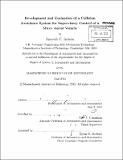Development and evaluation of a collision avoidance system for supervisory control of a micro aerial vehicle
Author(s)
Jackson, Kimberly F
DownloadFull printable version (10.79Mb)
Other Contributors
Massachusetts Institute of Technology. Dept. of Aeronautics and Astronautics.
Advisor
Mary L. Cummings.
Terms of use
Metadata
Show full item recordAbstract
Recent technological advances have enabled Unmanned Aerial Vehicles (UAVs) and Micro Aerial Vehicles (MAVs) to become increasingly prevalent in a variety of domains. From military surveillance to disaster relief to search-and-rescue tasks, these systems have the capacity to assist in difficult or dangerous tasks and to potentially save lives. To enable operation by minimally trained personnel, the control interfaces require increased usability in order to maintain safety and mission effectiveness. In particular, as these systems are used in the real world, the operator must be able to navigate around obstacles in unknown and unstructured environments. In order to address this problem, the Collision and Obstacle Detection and Alerting (CODA) display was designed and integrated into a smartphone-based MAV control interface. The CODA display uses a combination of visual and haptic alerts to warn the operator of potential obstacles in the environment to help the operator navigate more effectively and avoid collisions. To assess the usability of this system, a within-subjects experiment was conducted in which participants used the mobile interface to pilot a MAV both with and without the assistance of the CODA display. The task consisted of navigating though a simulated indoor environment and locating visual targets. Metrics for the two conditions examined performance, control strategies, and subjective feedback from each participant. Overall, the addition of the CODA display resulted in higher performance, lowering the crash rate and decreasing the amount of time required to complete the tasks. Despite increasing the complexity of the interface, adding the CODA display did not significantly impact usability, and participants preferred operating the MAV with the CODA display. These results demonstrate that the CODA display provides the basis for an effective alerting tool to assist with MAV operation for exploring unknown environments. Future work should explore expansion to three-dimensional sensing and alerting capabilities as well as validation in an outdoor environment.
Description
Thesis (S.M.)--Massachusetts Institute of Technology, Dept. of Aeronautics and Astronautics, 2012. Cataloged from PDF version of thesis. Includes bibliographical references (p. 195-108).
Date issued
2012Department
Massachusetts Institute of Technology. Department of Aeronautics and AstronauticsPublisher
Massachusetts Institute of Technology
Keywords
Aeronautics and Astronautics.